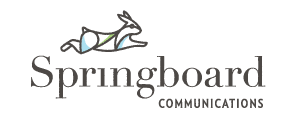Making the Case for Discovery (Part 1)
Every educator I’ve ever known constantly feels like they’re behind the eight ball, including communicators who support educators. Too often, they’re asked to churn out work within a week, or maybe within a day. Getting it right becomes second-priority to getting it out the door.
You feelin’ me on this one? In case it helps, you’re not alone. I frequently find myself needing to convince partners of the value of thoughtful planning at the beginning of a project. In this series, I’ll share some examples of the stories I tell that help me persuade partners to invest time in strategic planning, including discovery and primary research.
Finding data that connected local work with a national conversation
Have you ever encountered a data point that literally took your breath away? Neither had I, until I conducted an otherwise routine discovery process with PEBC. As I’ve written about here and here, PEBC engaged Springboard Communications to help them announce their planned merger of two teacher-prep programs to create the largest teacher residency in Colorado. As part of the discovery process we agreed upon, I asked them to send me any content they used frequently in presenting the residencies to their audiences, and reviewed about 15 different documents. One of those documents contained this paragraph:
“While teachers are widely recognized as the most important factor in improving student achievement, research has shown that students with the highest needs have the least access to high-quality teachers. Fifty percent of the individuals who complete a degree in education never actually go into teaching. Of those who begin their career as teachers, 30%-50% leave in one to three years. The attrition rate is highest in Title I schools; schools with the highest number of at-risk kids.”
Sooo, to paraphrase, half of all people who go to school to become teachers never set foot in the classroom. Half of those who remain subsequently leave the profession within three years. And poor kids, who need great teachers the most, are hit hardest by this teacher-dropout epidemic.
If that doesn’t hit you right between the eyes, you’ve probably accidentally hit the wrong website.
With this insight, we had context to frame our story about a merger between two teacher-prep programs as a story about work that is helping to reverse disastrous national trends in teacher preparation and teacher retention. This is because PEBC’s Boettcher Teacher Residency retains teachers at a rate of 94% after five years.
The bottom line here is, I’m not sure this insight would have surfaced if PEBC hadn’t been willing to support the time it took for me to review those dozens of pages of background documentation. I suppose it may have come up in our in-person discovery session or even in conversation, but organizations that do incredible things often forget to talk about the “why” behind that work. Or may not realize the power that data has to tell an incredible story.
I’ll end this story by contrasting the impact of this discovery process — a sexy story angle that resulted in widespread media coverage — with the time it took to complete it: a modest four hours. I’d call that time very well spent, and I hope it helps you argue for a similar amount of planning time as you approach your next project.
Market research that revealed the soul of a school district
In Part 2 of Making the Case for Discovery, I’ll talk about a school district that was eager to dash off a rebranding process in a hurry, and what happened after I convinced them to slow down long enough to involve stakeholders in the process.
